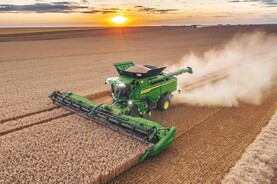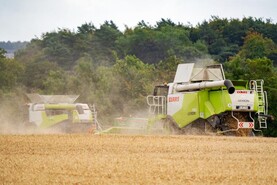This week’s heavy rainfall will temporarily curtail harvesting of winter tillage crops.
However, there is already significant volumes of straw, hay and grain on the move and this is only going to intensify in the coming weeks.
There have been a number of incidents in recent weeks of loads of straw and hay going up in flames, while the risk of loads becoming undone can have grave consequences for the operator and public safety.
Therefore, it is critical to ensure the transportation of hay, straw or grain is planned, taking due regard for the health and safety of all involved. Revised standards for new and existing agricultural vehicles were introduced in January 2016 and these now govern all transportation on and off road.
The full details can be viewed on the Road Safety Authority website, and a review of some of the most important relevant aspects is detailed below.
Dimensions
The maximum length permitted for agricultural vehicles is listed as 12m or 18.75m when combined with a tractor and trailer or other interchangeable towed equipment.

Height and width restrictions should be adhered to in order to elimate the risk of loads coming in contact with overhead wires, trees and other vehicles.
The permitted height of 4.65m is relevant to all goods, with the exception of baled produce such as hay or straw, which are designated as being exempt from this height limitation.
With regards to the width of the vehicle, the following applies:
For agricultural tractors and trailers, the width shall not exceed 2.55m.For large tractors whose unladen weight exceeds 7.25t, the width shall not exceed 2.75m. The permissible width for tractors with flotation tyres or dual wheel systems is listed as 3.5m. For fully mounted equipment and interchangeable towed equipment, the width is 3m. Self-propelled agricultural machinery, including combine harvesters, shall not exceed 3.5m. The exception to this is self-propelled agricultural machinery travelling on a public road that has an escort vehicle. The escort vehicle must drive in front, use dipped headlights and carry functioning amber beacons and a “caution –wide load following” sign. The machinery being escorted must also possess flashing amber beacons, one of which must be visible to the rear while also displaying a “wide load” sign at the back of the vehicle. The RSA standards advise that flotation tyres and mudguard flaps may protrude up to 100mm beyond the vehicle’s bodywork width and that this additional width is not included on each side of the vehicle. The same applies for devices associated with rear door opening mechanisms.
Weight concerns
Weight will generally not be an issue where transporting 4x4 round bales of hay and straw but is very relevant where transporting large square bales, which are significantly denser, and grain.
The revised standards introduced in 2016 also included revisions to national weight limits. A weight limit of 18t applies to two-axle agricultural trailers while three-axle trailers have a limit of 24t.

The weight of grain in trailers can vary depending on the moisture content and this should be taken into account.
The weight limits differ slightly for rigid drawbar (ie unbalanced) single, tandem and triaxle agricultural trailers, with these set at 13t, 19t and 22.5t respectively.
There are higher limits of up to 24t and 34t for unbalanced tandem and triaxle agricultural trailers that meet a number of additional requirements. These include the following:
Trailers must be plated.They must be fitted with a flexible suspension system.They must be fitted with flotation tyres for operation at 10t/axle in the case of a tandem axle trailer or 9t/axle in the case of a triaxle trailer.They must be fitted with a steered or steering axles if they have an axle spacing of 1.8m or greater.The standards also require that combinations of agricultural tractors and trailers, where either the tractor or trailer is unplated, have their maximum towing capacity capped at three times the tractor’s unladen weight. The document also lists requirements for the maximum vertical load that can be exerted on a tractor’s coupling by a trailer’s drawbar. This must not exceed (1) the lower of the tractor or trailer manufacturer’s specifications, (2) 3t or (3) 4t in the case of a ball-and-spoon-type coupling which has been approved and plated for this load.
Useful advice
Machinery and equipment used should be up to the task and have passed relevant safety checks. Operators should also be competent in operating the machinery and possess the necessary training required.
Where travelling on the road, avoid high speeds and be mindful of the effect that the weight of a load may have on braking effectiveness.

Where travelling long distances straps should be checked regularly and refasten or tightened where necessary.
Due regard should be taken of any slopes or uneven ground when travelling on land, while anyone involved should be always made aware to the presence of overhead electricity wires. Always avoid the temptation to overload trailers, no matter how short the distance being travelled.
Loads should be secured in place with double straps used at the rear of loads. Where travelling long distances, it is advisable to make regular stops, checking and refastening straps where required.
Dust and hay/straw particles should be cleared from any areas such as exhausts and brake systems where there is a risk of combustion. A fire extinguisher should be carried on the vehicle and checked regularly.
This week’s heavy rainfall will temporarily curtail harvesting of winter tillage crops.
However, there is already significant volumes of straw, hay and grain on the move and this is only going to intensify in the coming weeks.
There have been a number of incidents in recent weeks of loads of straw and hay going up in flames, while the risk of loads becoming undone can have grave consequences for the operator and public safety.
Therefore, it is critical to ensure the transportation of hay, straw or grain is planned, taking due regard for the health and safety of all involved. Revised standards for new and existing agricultural vehicles were introduced in January 2016 and these now govern all transportation on and off road.
The full details can be viewed on the Road Safety Authority website, and a review of some of the most important relevant aspects is detailed below.
Dimensions
The maximum length permitted for agricultural vehicles is listed as 12m or 18.75m when combined with a tractor and trailer or other interchangeable towed equipment.

Height and width restrictions should be adhered to in order to elimate the risk of loads coming in contact with overhead wires, trees and other vehicles.
The permitted height of 4.65m is relevant to all goods, with the exception of baled produce such as hay or straw, which are designated as being exempt from this height limitation.
With regards to the width of the vehicle, the following applies:
For agricultural tractors and trailers, the width shall not exceed 2.55m.For large tractors whose unladen weight exceeds 7.25t, the width shall not exceed 2.75m. The permissible width for tractors with flotation tyres or dual wheel systems is listed as 3.5m. For fully mounted equipment and interchangeable towed equipment, the width is 3m. Self-propelled agricultural machinery, including combine harvesters, shall not exceed 3.5m. The exception to this is self-propelled agricultural machinery travelling on a public road that has an escort vehicle. The escort vehicle must drive in front, use dipped headlights and carry functioning amber beacons and a “caution –wide load following” sign. The machinery being escorted must also possess flashing amber beacons, one of which must be visible to the rear while also displaying a “wide load” sign at the back of the vehicle. The RSA standards advise that flotation tyres and mudguard flaps may protrude up to 100mm beyond the vehicle’s bodywork width and that this additional width is not included on each side of the vehicle. The same applies for devices associated with rear door opening mechanisms.
Weight concerns
Weight will generally not be an issue where transporting 4x4 round bales of hay and straw but is very relevant where transporting large square bales, which are significantly denser, and grain.
The revised standards introduced in 2016 also included revisions to national weight limits. A weight limit of 18t applies to two-axle agricultural trailers while three-axle trailers have a limit of 24t.

The weight of grain in trailers can vary depending on the moisture content and this should be taken into account.
The weight limits differ slightly for rigid drawbar (ie unbalanced) single, tandem and triaxle agricultural trailers, with these set at 13t, 19t and 22.5t respectively.
There are higher limits of up to 24t and 34t for unbalanced tandem and triaxle agricultural trailers that meet a number of additional requirements. These include the following:
Trailers must be plated.They must be fitted with a flexible suspension system.They must be fitted with flotation tyres for operation at 10t/axle in the case of a tandem axle trailer or 9t/axle in the case of a triaxle trailer.They must be fitted with a steered or steering axles if they have an axle spacing of 1.8m or greater.The standards also require that combinations of agricultural tractors and trailers, where either the tractor or trailer is unplated, have their maximum towing capacity capped at three times the tractor’s unladen weight. The document also lists requirements for the maximum vertical load that can be exerted on a tractor’s coupling by a trailer’s drawbar. This must not exceed (1) the lower of the tractor or trailer manufacturer’s specifications, (2) 3t or (3) 4t in the case of a ball-and-spoon-type coupling which has been approved and plated for this load.
Useful advice
Machinery and equipment used should be up to the task and have passed relevant safety checks. Operators should also be competent in operating the machinery and possess the necessary training required.
Where travelling on the road, avoid high speeds and be mindful of the effect that the weight of a load may have on braking effectiveness.

Where travelling long distances straps should be checked regularly and refasten or tightened where necessary.
Due regard should be taken of any slopes or uneven ground when travelling on land, while anyone involved should be always made aware to the presence of overhead electricity wires. Always avoid the temptation to overload trailers, no matter how short the distance being travelled.
Loads should be secured in place with double straps used at the rear of loads. Where travelling long distances, it is advisable to make regular stops, checking and refastening straps where required.
Dust and hay/straw particles should be cleared from any areas such as exhausts and brake systems where there is a risk of combustion. A fire extinguisher should be carried on the vehicle and checked regularly.









 This is a subscriber-only article
This is a subscriber-only article










SHARING OPTIONS: